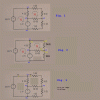Hello again,
Ok, but he was asking for nodal not mesh analysis right? That means the way those currents are drawn dont make sense.
Why don't they make sense? Mesh currents are certainly most directly associated with a mesh analysis, but that doesn't make then nonsense in a nodal analysis, just less directly associated with the nodal solution. They can be calculated from the node voltages, as you did, and the student could be asked to determine them from a nodal analysis for the reason I mention below.
The current labeled i1 in your figure 3 is the current in the 10 volt source. The current labeled i1 in the OP's image is the current in the 10 volt source. They are the same current. If the current i1 in the OP's image doesn't make sense, then the current labeled i1 in your figure 3 also doesn't make sense; they are identical.
On the other hand, if the current i1 in your figure 3 makes sense, then the current i1 in the OP's image also makes sense; they are the same current.
Similarly for i2.
It should be possible to solve for any set of currents using any of the standard methods of network analysis. But it's quite typical for one method to be more convenient than another with a given network and a given set of desired currents, and one of the things a student of network analysis should learn is how to tell when one method might be better than another.
Im sure what happened here was the original problem was using mesh analysis, then the student was asked to do the
circuit using nodal analysis later.
I asked him about that, and he hasn't responded. The OP is just learning circuit analysis, and I think it's also possible that he just didn't recognize that when mesh currents are shown, the problem author is trying to give a hint as to an appropriate method of solution.
But I can also imagine an instructor directing a student to use an inappropriate method for the purpose of giving the student an object lesson as to the value of knowing how to decide the
appropriate method.




